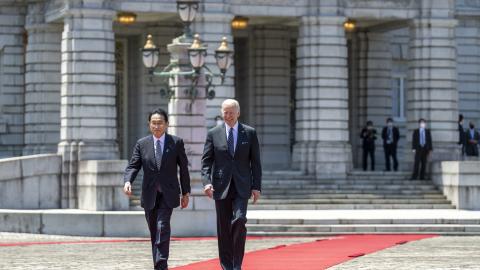The leaders of the Group of Seven (G7) will meet in May in Hiroshima, Japan. In preparation for a successful summit, Prime Minister Fumio Kishida is making the rounds this week by visiting G7 members France, Italy, the United Kingdom, Canada, and the US (Germany is the only country not on the itinerary).
Although not his first meeting with President Biden, this will be Kishida’s first visit to the White House since becoming prime minister in late 2021 and since Japan released its revised National Security Strategy just last month.
Kishida’s trip isn’t expected to be groundbreaking by any means, and is really just a way to reinforce some of the discussions planned between Japan and its G7 partners on climate, energy, technology, global health, and other economic and security matters. It’s also a way for him to drum up media interest for the summit.
But with Kishida visiting the US last, it may be less about saving the best for last and more about getting the easy trips out of the way first.
The US-Japan alliance is considered the cornerstone of peace and prosperity in the Indo-Pacific. For all intents and purposes, the US-Japan partnership is as good as it has ever been.
Over the past couple of years, the US and Japan have launched a plethora of bilateral initiatives, including the Global Digital Connectivity Partnership, Competitiveness and Resilience Partnership, Commercial and Industrial Partnership, Economic Policy Consultative Committee (Economic 2+2), and Energy Security Dialogue, to name a few.
These efforts, along with the release of Japan’s National Security Strategy, will put a lot more pressure on American and Japanese officials to start delivering results.
For example, the new security strategy places an even greater importance on the alliance. The strategy not only shares a similar view that China has become a challenge for Japan and the Indo-Pacific but adds new areas for US-Japan cooperation in space and cyberspace. It’s expected that there will be difficulties in coordinating and integrating American and Japanese joint operations in the years to come. But while this transformation will be a bit of a messy one, it’s a necessary one.
So, as much as Kishida’s visit to the US is about preparing for the G7, his time in Washington also will be about making sure that Japan and US relations start the new year off on the right foot. No doubt, Kishida is expected to receive a warm welcome. Biden and other senior officials were some of the first to praise Japan’s release of its new National Security Strategy.
But there are other headwinds to the US-Japan relationship—many of them economic issues and many of them causing Kishida frustration. Irritants, such as the Inflation Reduction Act’s preferential tax credit for electric vehicles assembled in North America and recent export controls on semiconductor sales to China, have irked Japanese businesses.
Japanese officials have been good enough to not let economic issues overshadow the security cooperation efforts, though. For example, it’s still Japan’s official opinion that the US should try to join the Trans-Pacific Partnership. Instead, the Biden administration is wasting time on its alternative: the Indo-Pacific Economic Framework (IPEF). Japanese officials are some of the biggest supporters of IPEF but recognize its failures: that America’s trade and economic policies in Asia are substandard—which says a lot given the US is hosting the Asia-Pacific Economic Cooperation (APEC) meeting later this year.
Energy security also has become a new joint effort for the US and Japan, especially given that Russia’s invasion of Ukraine has impacted the global energy market. But despite new agreements being signed by American and Japanese officials for energy cooperation, America’s own domestic restrictions limit what the country can actually provide to Japan.
There are lots of opportunities for the US and Japan this year, and not just from Japan’s hosting of the G7 summit or at APEC. But there are a number of hurdles to jump, with more to come in the months and years ahead. Many of those hurdles are made in the US.
The partnership between the US and Japan is more important than ever. China’s belligerent military and economic activities show no sign of slowing down. North Korea has made an effort in the past year to remind those in the region that it’s still a threat. Economic prosperity across the Indo-Pacific is being called into question as countries talk more about bringing their supply chains home. And America’s allies in Japan are at the forefront of this all.
It will be important that Kishida’s visit with Biden reaffirms the US-Japan alliance, partnership, and friendship as these get put to the test. But sure enough, the year ahead for US-Japan relations will be one of the most exciting to watch in the Indo-Pacific.




















